
Health
Making Sense of Alternative Medicine
Complementary and alternative medicine -- good or bad?
Posted September 10, 2010
Whether we like it or not, the lines between allopathic and alternative medicine continue to blur. Just last week I recommended glucosamine-chondroitin to a patient who suffers from osteoarthritis and wrote a prescription for Lovaza, a prescription-strength preparation of fish oil. And today I was asked about red yeast rice from a patient interested in controlling her cholesterol through "natural means."
Like nutrition, complementary and alternative medicine, or CAM, is somewhat of a "dismal science" (see link). It seems nearly everyone has a different opinion about CAM and that from infomercial actors to the local barber everyone has different remedies to recommend.
Inevitably we know that many "alternative" therapies are likely to be safe and effective - after all, many modern day medicines originated as natural remedies - for example, aspirin, which was derived from willow bark. But the problem is that the "signal-to-noise" ratio is too low. That is, there is so much junk out there that it makes it difficult to separate the occasional good from the mostly bad.
In the face of this uncertainty and our ever-increasing time constraints, the approach that many young doctors like myself make is to simply dismiss the entire field. Back in September, during the first few months of my internship, I found myself in our urgent care center evaluating a 50-something year-old man with knee pain. After diagnosing him with osteoarthritis, my supervising doctor recommended that I prescribe glucosamine. "Glucosa-what?," I asked skeptically. "Glucosamine - it's a natural remedy. I find that a lot of my patients really benefit from it." I tried my best not to laugh at the suggestion. Doctors are supposed to recommend therapies based on evidence, not anecdotes. Why should I peddle unproven "alternative remedies" when effective medications are available? But the truth is that I knew nothing about the data for or against glucosamine, or about glucosamine for that matter. In the absence of any information, and in the midst of a busy clinic day, my knee-jerk response was to dismiss his recommendation.
Doctors are commonly viewed by patients and by the public in general as experts in health, and CAM is no exception. But the truth is that doctors receive very little formal training in CAM. And this lack of training is exacerbated by the fact that CAM is often treated as distinct from mainstream medicine and is viewed skeptically, if not disparagingly, by many physicians. The difficulty many doctors and patients have with CAM is that they do not know how to separate the good from the the bad. But, in reality, allopathic medicine and CAM are really not that different. The major distinguishing characteristic is that the FDA has the authority to regulate allopathic medicines but not herbal ones. But why should this matter to us as practicing clinicians?
The basic notion that CAM is fundamentally no different from conventional medicine allows us to use the same methods to evaluate the merits of CAM as we use for allopathic medicine. Take for instance glucosamine. Several large scale clinical trials, including double blind placebo-controlled trials (the gold standard in medicine), have been done to evaluate the use of glucosamine, chondroitin, and glucosamine-chondroitin for the treatment of osteoarthritis. While some of these trials have not demonstrated any benefit, a review of the data published in JAMA in 2000 concluded that despite limited data "...some degree of efficacy appears probable for these preparations."*
This example illustrates the point that evaluating the clinical use of a CAM therapy really isn't much different than evaluating an allopathic one. Many CAM therapies have been evaluated in clinical studies, and sometimes even double-blind placebo-controlled trials. Often those that haven't have at least been studied for their safety. Our jobs as clinicians then is to apply a formula we have become accustomed to - find the relevant scientific literature and then weigh the known risks and benefits in the context of the individual patient.**
I've come to realize that I don't need to know everything about complementary and alternative medicine. (Even if I wanted to, I couldn't.) But to be an effective clinician what is required is to listen to my patients, keep an open mind, and, when called upon, evaluate the best available evidence and determine how it applies to the patient in front of me. Call it complementary. Call it alternative. But in the end it is what medicine is all about.
Copyright Shantanu Nundy, M.D.
If you enjoyed this post, please visit Dr. Nundy's web site BeyondApples or read his book, Stay Healthy At Every Age.
* See link. For accompanying editorial, see link.
** One major difference worth pointing out, however, is in how we "prescribe" CAM. Herbal medicines and supplements are not regulated by the FDA, which means they do not require a prescription. More importantly, it also means that the manufacturing and distribution of these products are largely unregulated. As a result, different preparations of the same product can have widely different content. Product X may have significantly different amounts of a therapeutic agent than Product Y and may even have a number of other active compounds within it. While this isn't a deal breaker, it does mean that doctors have to be vigilant about the quality and content of the CAM therapies their patients are taking.

